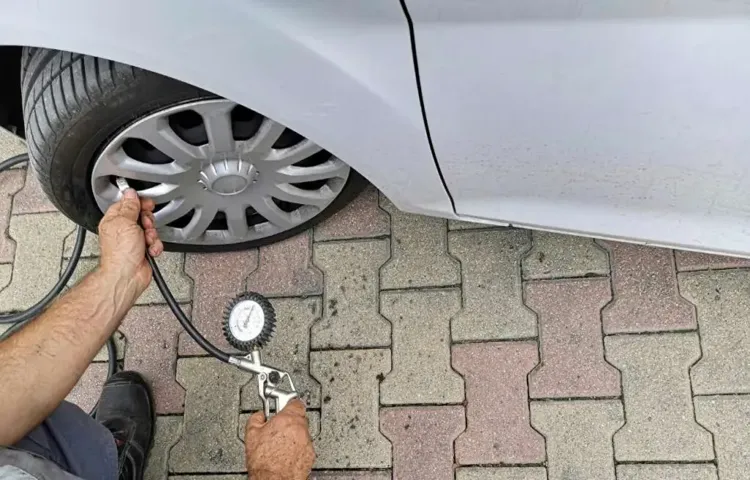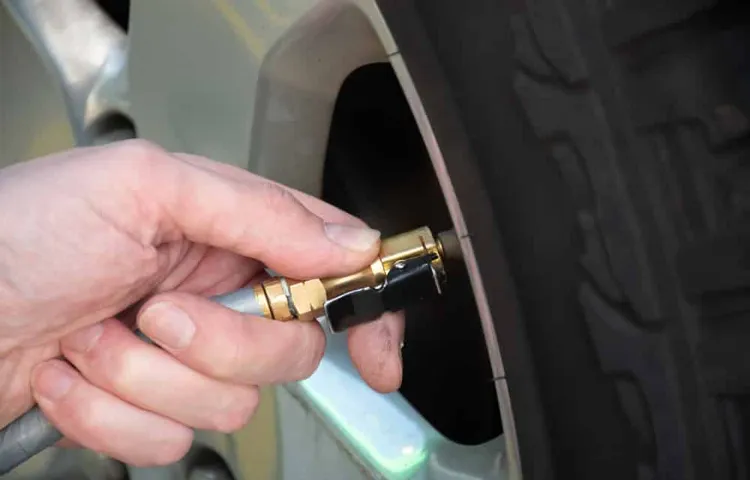Nothing is more frustrating than realizing that your tire is low on air while driving. Thankfully, most gas stations have an air pump available for customers to use. However, if you don’t know how to properly pump air into your tire at a gas station, it can be a confusing and intimidating experience.
But don’t worry, it’s actually a simple process once you know what to do. In this blog post, we’ll guide you through the steps on how to pump air into your tire at a gas station, so you can feel confident and safe on the road.
Table of Contents
Locating the Air Pump
Are you feeling clueless on how to pump air into your tire at a gas station? Don’t worry, you’re not alone. Locating the air pump can sometimes be a challenge, especially if you’re at a new or unfamiliar gas station. First, you’ll need to park near the air pump, which is often positioned near the fuel station or car wash area.
Once you’ve located it, check to ensure that it’s in good working condition and choose the correct air pressure gauge based on your vehicle’s recommended PSI. Don’t forget to remove any debris or objects from the valve stem before attaching the air hose to the valve. With these simple steps, you’ll be on your way to a safe and properly inflated tire in no time!
Look for a sign or ask the gas station attendant
When it comes to locating the air pump at a gas station, there are a few different methods you can use. First, look for a sign – many gas stations will have signs pointing you towards the air pump, usually located near the edge of the lot. If you don’t see a sign, your next best option is to ask the gas station attendant.
They’ll be able to direct you to the air pump and answer any questions you might have about using it. Don’t be afraid to ask – it’s part of their job to help customers! Some gas stations may also have air pumps that are located within a small booth or kiosk; in this case, you may need to use a credit card or cash to pay for the air before you can use it. Regardless of the specific setup, always make sure to double-check the pressure in your tires before driving off – maintaining proper tire pressure is important for both your safety and the longevity of your vehicle.

Preparing to Inflate the Tire
Are you wondering how to pump air into tire at gas station? Before you begin, it’s important to check the recommended pressure for your tires – this can be found in your car’s owner manual or on a sticker on the driver’s side door. Once you know the appropriate pressure, pull up to the air pump and park your car nearby. Be sure to turn off the engine and engage the parking brake.
Next, remove the valve cap from the tire and attach the hose of the air pump. Depending on the gas station, you may need to enter a coin or press a button to activate the air pump. Begin adding air to your tire in short bursts, checking the pressure with a tire gauge periodically.
Once you reach the recommended pressure, quickly remove the hose and replace the valve cap. Repeat the process for each tire that needs air. Pumping air into your tires may seem intimidating at first, but with the right tools and a little know-how, it’s a simple process.
Check the recommended PSI for your tire
When it comes to inflating your tire, it’s essential to know the recommended PSI (pounds per square inch) for your specific tire. This information can typically be found in your vehicle’s owner manual or on the tire itself. It’s imperative to inflate your tires to the proper PSI to avoid damage to the tire and ensure safe driving conditions.
Underinflated tires can lead to poor handling and decreased fuel efficiency, while overinflated tires can cause dangerous blowouts. It’s crucial to check the recommended PSI before inflating your tires and to keep a tire pressure gauge handy to regularly monitor your tire’s pressure. By doing so, you’ll be keeping your tires in good condition and promoting safe driving habits.
Remove the valve cap from the tire
When preparing to inflate your tire, the first step is to remove the valve cap from the tire. This might seem like a no-brainer, but it’s an essential part of getting air into your tire. The valve cap protects the valve stem from dust, dirt, and moisture, but it also prevents air from escaping the tire.
It’s essential to remove the cap before inflating the tire to ensure that air can flow freely into the valve stem. To remove the cap, simply unscrew it from the valve stem. You might need to use pliers or your fingers to get a good grip on the cap, particularly if it’s tight.
However, be careful not to exert too much force, as you could damage the valve or the cap. Once the valve cap is removed, take a moment to inspect the valve stem and make sure it’s in good condition. If you notice any damage, such as cracks or tears, you’ll need to replace the valve stem before inflating the tire.
In conclusion, removing the valve cap is the first step to inflating your tire properly. It’s a simple but essential task that should be done carefully to prevent any damage to the valve stem or cap. Always make sure the valve stem is in good condition before inflating the tire to ensure safe driving conditions.
So, make sure to add this step to your tire-inflating routine to keep your vehicle running smoothly.
Using the Air Pump
Have you ever found yourself at a gas station needing to pump air into your tire? It can be a bit confusing if you’ve never done it before. First, make sure to locate the air pump at the gas station. They are usually located near the gas pumps or in a separate area of the station.
Next, check the recommended PSI (pounds per square inch) for your tire, which can be found in your vehicle’s owner manual or on a label inside the driver’s side door. Once you know the recommended PSI, unscrew the valve cap from your tire and attach the hose from the air pump to the valve stem, making sure it’s tightly secured. Press the button on the pump to start filling the tire with air.
The gauge on the pump will show you the current PSI. Release air from the tire if the pressure gets too high, or add more air as needed until you reach the recommended PSI. Finally, remove the hose from the valve stem and replace the valve cap.
Congratulations! You’ve successfully pumped air into your tire at the gas station. It’s a simple task that can save you from a potentially dangerous situation on the road.
Attach the air hose to the valve stem
When it comes to using an air pump to inflate tires, the first step is to attach the air hose to the valve stem. But before doing so, it’s important to double-check the recommended tire pressure, which can usually be found in the owner’s manual or on the tire itself. Once you’ve got that information, simply press the nozzle of the air hose onto the valve stem and lock it in place.
You should be able to hear a slight hissing sound as the air flows into the tire. While inflating, keep an eye on the pressure gauge to ensure you’re not over-inflating the tire. Once you’ve reached the desired pressure, remove the air hose carefully and replace the valve cap.
It’s important to note that properly inflated tires not only increase safety on the road but can also improve fuel efficiency and reduce tire wear. So don’t forget to regularly check and inflate your tires to keep them in top condition!
Set the PSI on the air pump
When it comes to using an air pump, it’s crucial to set the PSI (pounds per square inch) correctly, or you risk over-inflating or under-inflating your tires, which can lead to safety issues on the road. To set the PSI, first, you need to find out the recommended air pressure for your specific vehicle. You can usually find it in the owner’s manual or on the sticker located on the driver’s side door jamb.
Once you know the recommended PSI, attach the air pump to your tire valve stem and turn it on. Use a tire gauge to measure the current PSI and compare it to the recommended PSI. If it’s underinflated, add air until you reach the recommended PSI.
If it’s overinflated, use the air release valve to let air out until you reach the recommended PSI. Remember to check your tire pressure every month, especially during temperature changes, to ensure your tires are properly inflated. By setting the PSI correctly, you’ll have a safer and smoother driving experience.
Press the lever to begin inflating the tire
Using an air pump to inflate your tire is not as daunting as it may seem. To begin, locate the nozzle on the pump and make sure it is securely attached to the valve on the tire. Then, press the lever to begin inflating the tire.
As the tire fills with air, you will hear a hissing sound. It is essential to periodically check the pressure gauge to make sure you do not overinflate the tire. Once the tire reaches the recommended pressure, which can typically be found in the car manual or on the tire itself, you can stop inflating and detach the nozzle from the valve.
It’s important to remember that maintaining proper tire pressure not only ensures a smoother ride, but it also improves fuel economy and helps prolong the life of your tires. So, the next time you need to use an air pump, don’t be intimidated- just press the lever and get inflating.
Checking the Tire’s Inflation
If you’ve ever found yourself at a gas station with a flat tire, you’re in luck because most gas stations have air pumps available for public use. Before you begin pumping air into your tire, it’s important to first check the current inflation level. You can find the recommended tire pressure for your vehicle in your owner’s manual or on the tire itself.
Once you have this information, simply remove the valve cap from the tire and attach the air hose to the valve stem. Press the lever on the air pump to start inflating the tire, and be sure to check the pressure with a tire gauge periodically. If the tire pressure reaches the recommended level, stop pumping and remove the air hose.
Remember, overinflation can be just as dangerous as underinflation, so be mindful and take your time. With just a little bit of effort, you can ensure that your tires are properly inflated and ready for the road ahead!
Use a tire pressure gauge to check the PSI
Checking your vehicle’s tire pressure regularly is an important aspect of car maintenance that ensures a safe and comfortable driving experience. Under-inflated tires can lead to poor fuel economy, reduced handling, and increased tire wear, while over-inflated tires can cause blowouts and decreased traction. To check your tire’s inflation, use a tire pressure gauge and locate the recommended pressure listed on the driver’s side door or in the owner’s manual.
Press the gauge onto the valve stem and wait for the air pressure reading. If the tire pressure is too low, use an air pump to inflate the tire to the recommended level. Remember, tires lose pressure naturally over time, so it’s crucial to check them at least once a month and before any long trip.
By keeping your tires properly inflated, you increase your safety on the road, reduce fuel consumption, and extend the life of your tires.
Adjust the inflation as needed
Checking the tire’s inflation is essential for ensuring your safety while driving and prolonging the lifespan of your tires. Underinflated or overinflated tires can cause a variety of issues such as decreased fuel efficiency, increased tread wear, and even blowouts. To avoid these problems, it’s important to keep an eye on your tire’s inflation regularly.
You can easily check your tire’s inflation with a tire pressure gauge, which can be purchased at most auto stores. Simply attach the gauge to the valve stem on your tire and read the pressure levels. If the pressure is too low, add air until the pressure matches the recommended level listed in your vehicle’s manual.
On the other hand, if the pressure is too high, release some air until it reaches the recommended level. Remember to adjust the inflation as needed, especially during temperature changes. For every 10 degree Fahrenheit change in temperature, tire pressure can fluctuate by one pound per square inch.
By checking your tire’s inflation regularly, you’ll maintain optimal tire performance and overall vehicle safety.
Final Thoughts
If you find yourself needing to pump air into your tire at a gas station, don’t worry! It’s a simple process that just requires a few steps. First, locate the air pump at the gas station, which is usually near the gasoline pumps or somewhere conspicuous. Make sure you have some quarters or a card if the pump requires payment.
Then, unscrew the valve cap on your tire and attach the air hose nozzle. Set the pressure to the recommended level for your vehicle, which can be found either in the owner’s manual or on a sticker inside the driver’s side door. Press the button to start the air flow and use the gauge to monitor the pressure level.
When you’re finished, disconnect the hose and replace the valve cap. It’s important to check your tire pressure regularly to make sure they’re properly inflated, as this affects your safety and gas mileage. So, next time you need to pump air into your tire at a gas station, remember, it’s a breeze!
Regularly checking and maintaining tire inflation is important for safety and the longevity of your tires
Regularly checking and maintaining tire inflation is vital for your safety while driving and the longevity of your tires. Driving on improperly inflated tires can lead to decreased fuel efficiency, premature wear and tear, and even a blowout on the road. This is why it’s important to make sure your tires are inflated to the proper pressure levels recommended by your manufacturer.
Checking your tire pressure regularly, especially before long trips, is crucial to ensure optimal tire performance and safety. Additionally, having a tire gauge and keeping it in your car can help you monitor your tire pressure and take action when necessary. By taking the time to maintain proper tire inflation, you’ll not only be ensuring a safe and enjoyable driving experience, but you’ll also be extending the life of your tires and saving money in the long run.
So, do yourself a favor and make tire inflation checks a regular part of your routine maintenance schedule.
Conclusion
So there you have it, pumping air into your tire at a gas station is a breeze! Just follow these simple steps and you’ll be on your way to a smoother ride in no time. Plus, you’ll impress your friends with your expert tire-inflation skills. Remember, keeping your tire pressure at the recommended level not only ensures a smoother ride but also promotes better fuel efficiency, which means you’ll save money and help the environment.
So pump away and drive on, my friend!”
FAQs
Why is it important to check tire pressure regularly?
Maintaining proper tire pressure is crucial for optimum vehicle performance, fuel efficiency, and safety. Overinflated or underinflated tires can have negative effects on both handling and braking.
Can I pump air into my tire at any gas station?
Yes, most gas stations have air pumps available for customers to use. Some stations may require payment, so make sure to have coins or a card on hand.
How do I know how much air to put in my tire?
Refer to the tire pressure specifications in your vehicle’s owner’s manual or on the tire itself. Be sure to check the pressure when the tires are cold, as the pressure will increase as the tires heat up during use.
What should I do if my tire pressure is too low?
Use the air pump at the gas station to add air to the tire, being careful not to overinflate it. Check the tire pressure again and adjust as needed.
Can I use a gas station air pump to inflate other objects, such as basketballs or inflatable pool toys?
It is possible, but not recommended. Gas station air pumps are designed specifically for tires and may not have the correct adapter or pressure settings for other objects.
How often should I check my tire pressure?
It is recommended to check the tire pressure at least once a month and before any long road trips.
What should I do if I am unsure how to use the air pump at the gas station?
Many gas stations have instructions posted on the pump, or you can ask the attendant for assistance. It’s important to use the pump correctly to avoid damage to the tire or injury.



